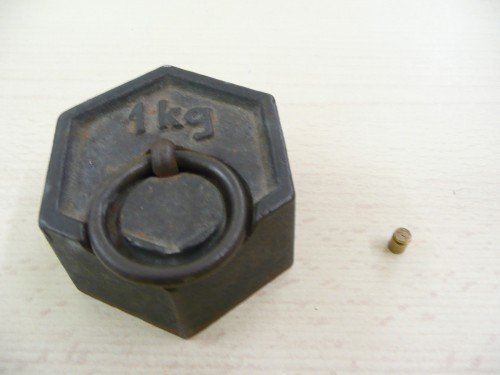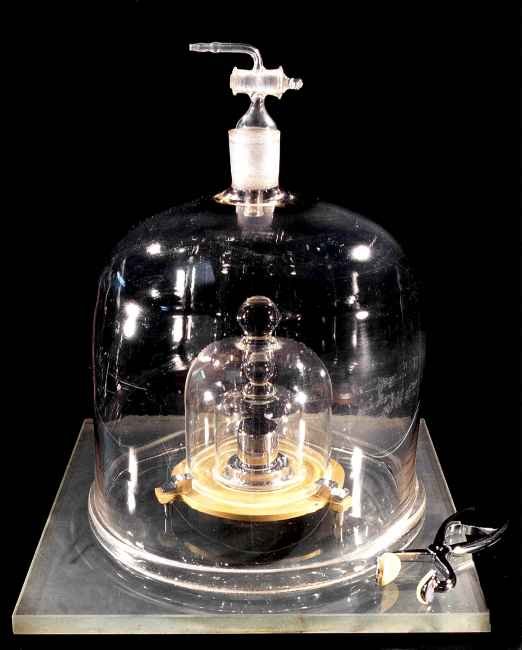Measurements: History of the Kilogram

source
See also:
History of the Kilogram
Similar to what happened to the measurement of distances, for many centuries there were no universal unit of mass.
Ancient Units
In most European countries, mass was given in units called "pounds" or equivalent. But the value of one pound depended on the country and on the usage.
The ancestor of the pound is the the Roman libra that was equivalent to approximately 328.9 grams. The word "libra" is the root of the French word "livre" (pound).
The English word "pound" derives
from a borrowing into Proto-Germanic of the Latin expression lībra pondō ("a pound by weight")
In England, there were different "pounds": Troy pound, tower pound, merchant's pound, London pounds, with different values from 350 to 467 grams. However, the most important pound is the "avoirdupois" pound that is around 454 grams. The word avoirdupois comes from Anglo-Norman French "aveir de peis" meaning "goods of weight", and not from modern French "avoir du poids", meaning "to have weight".
In France, various "livres" have been in use, for example the "livre esterlin" (367.1 grams) and "livre poids de marc" or "livre de Paris" (489.5 grams).
A smaller mass unit was also used in various countries: the grain. But, like the pound, it had different values: 64.8 milligrams in England, 53.1 milligrams in France.
First definition: the Kilogramme des Archives
John Wilkins in 1668 suggested that a universal mass (or weight) unit could be some well defined volume of water.
In 1793, the Commission of Weights and Measures, appointed by the French Academy of Sciences, decided that the unit of mass would be a cubic decimetre of distilled water at 0°C. It gave it the name of "grave". Two other masses were defined: the "gravet" (1/1,000 grave) and the "bar" (1,000 graves).
A temporary prototype was built in brass. It was temporary, because the exact definition of the meter was not known before 1798.
In 1793, the names grave, gravet and bar were abandoned and a simple name was used, the "gramme" (gram). The grave was 1,000 grams, or one kilogram, and the gravet was 1 gram. The brass prototype of the grave was renamed to provisional kilogram.
The temperature specification of the kilogram was changed from 0°C to around 4°C, that is the temperature of the maximum density of water.
When the accurate definition of the metre was known in 1798, it was discovered that the temporary prototype was 0.09% too heavy. At the same time that the Mètre des Archives was made in 1799, a new prototype of the kilogram, replacing the temporary prototype of the grave, was made in platinum. It was also kept at the Archives of the Republic and was known as the "Kilogramme des Archives" (the Kilogram of the Archives). It will be the definition of the kilogram for almost a century.
International Prototype Kilogram
In 1879, a new kilogram prototype was made in a special alloy, 90% platinum and 10% iridium, by the London firm of Johnson Matthey. In 1883, its mass is shown to be exactly the same as the mass of the Kilogramme des Archives. And, in 1889, the new prototype became officially the new definition of the kilogram.
This prototype is known as the "IPK" or as the "Grand K". It is stored in a safe in the basement of the Pavillon de Breteuil near Paris.

International Prototype Kilogram
source
Several copies of the IPK have been made and distributed to the various nations of the world. These copies are designated as Knn, where 'nn' is a number.
For example, the United States has four copies: K4, K20, K79 and K85. Canada has two copies (K50 and K74), Hungary has one (K16), etc...
These copies are not exactly the same as the IPK. The difference of mass is known and checked from time to time.
For example, in 1889 it was determined that the American prototype K20 was 39 µg lighter that the IPK; in 1948 it was 19 µg lighter than the IPK and in 1999, the most recent check, it was found that its mas was indistinguishable from the mas of the IPK.
The mass of the IPK is the current definition of the kilogram in the international system of units.
Problems with the Use of a Physical Prototype
The actual mass of the IPK and of its copies changes slightly over time, for various reasons. Even though the IPK is stored in a controlled environment, it gains mass through adsorption of atmospheric contamination onto their surfaces. Consequently, from time to time, it is cleaned using a carefully designed method. But, cleaning may remove some mass.
Because the IPK is by definition the kilogram prototype, it is impossible to know if its mass has changed over the years.
What can be known are the difference of mass between the IPK and the various copies.
The value of the kilogram is used in the definition of two other units of the international system: the ampere and the candela.
So, in recent years, there have been proposals to defined all the international units, including the kilogram, without the need of a physical prototype. But these proposal have not yet been adopted and the IPK, after 128 years, is still the official definition of the kilogram.
Sources:

@vcelier you really like Math a lot to do some research and write about the history of the kilogram eh? Kudos to the effort! Are you a Math teacher? an engineer?
No, I am not a math teacher. As you can read under my name in my steemit page ( @vcelier ), I was a Navy officer (now retired) and I am now a software engineer (to be retired in the next 2 or 3 years).
But, yes, I like math and science.
@vcelier I see.. haven't noticed the profile texts till now.. thanks anyway